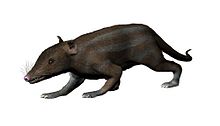Juramaia
| Juramaia Temporal range: ?
| |
|---|---|

| |
| Restoration | |
| Scientific classification | |
| Domain: | Eukaryota |
| Kingdom: | Animalia |
| Phylum: | Chordata |
| Class: | Mammalia |
| Subclass: | Theria |
| Genus: | †Juramaia Luo et al., 2011 |
| Species | |
Juramaia is an extinct genus of a therian mammal, possibly a very basal eutherian mammal, known from the Late Jurassic (Oxfordian stage) or Early Cretaceous deposits of western Liaoning, China.[1] It is a small shrew-like mammal measuring about 10 cm (3.9 in) long and weighing around 15–25 g (0.53–0.88 oz),[2][3] making it similar in size to the modern De Winton's shrew.[4]
Discovery[edit]
Juramaia is known from the holotype BMNH PM1343, an articulated and nearly complete skeleton including incomplete skull preserved with full dentition.[3] It was collected in the Daxigou site, Jianchang, from the Tiaojishan Formation dated at about 160 million years ago.[5] It was first named by Zhe-Xi Luo, Chong-Xi Yuan, Qing-Jin Meng and Qiang Ji in 2011 and the type species is Juramaia sinensis.[3]
Classification[edit]
The discovery of Juramaia provides new insight into the evolution of placental mammals by showing that their lineage diverged from that of the marsupials 35 million years earlier than previously thought.[3] Furthermore, its discovery fills gaps in the fossil record and helps to calibrate modern, DNA-based methods of dating the evolution.[6][7] Based on climbing adaptations found in the forelimb bones, it has been suggested that the basal stock of Eutheria was arboreal,[3] in a manner resembling that of modern rats.[8]
| |||||||||||||||||||||||||
However, Sweetman et al. (2017) considered Juramaia as a stem therian instead,[9] and the Late Jurassic dating has been questioned, with King et al. (2020) suggesting that Juramaia may originate from Early Cretaceous based on tip-dating analyses, which would make it contemporaneous to several other known eutherians.[1]
See also[edit]
References[edit]
- ^ a b King, Benedict; Beck, Robin M. D. (2020-06-10). "Tip dating supports novel resolutions of controversial relationships among early mammals". Proceedings of the Royal Society B: Biological Sciences. 287 (1928): 20200943. doi:10.1098/rspb.2020.0943. ISSN 0962-8452. PMC 7341916. PMID 32517606.
- ^ Prothero, Donald R. (November 15, 2016). The Princeton Field Guide to Prehistoric Mammals. Princeton University Press. p. 47. ISBN 9780691156828.
- ^ a b c d e Zhe-Xi Luo; Chong-Xi Yuan; Qing-Jin Meng; Qiang Ji (25 August 2011). "A Jurassic eutherian mammal and divergence of marsupials and placentals" (PDF). Nature. 476 (7361): 442–445. Bibcode:2011Natur.476..442L. doi:10.1038/nature10291. PMID 21866158. S2CID 205225806. Archived from the original (PDF) on 10 November 2013. Electronic supplementary material
- ^ Smith, Andrew T.; et al. (2010-04-23). A Guide to the Mammals of China. p. 308. ISBN 978-1400834112.
- ^ Chu, Z.; He, H.; Ramezani, J.; Bowring, S.A.; Hu, D.; Zhang, L.; Zheng, S.; Wang, X.; Zhou, Z.; Deng, C.; Guo, J. (2016). "High-precision U-Pb geochronology of the Jurassic Yanliao Biota from Jianchang (western Liaoning Province, China): Age constraints on the rise of feathered dinosaurs and eutherian mammals". Geochemistry, Geophysics, Geosystems. 17 (10): 3983–3992. Bibcode:2016GGG....17.3983C. doi:10.1002/2016GC006529.
- ^ "Fossil redefines mammal history" BBC News
- ^ Discovery of a 160-million-year-old fossil represents a new milestone in early mammal evolution
- ^ Bonnan MF, Shulman J, Varadharajan R, Gilbert C, Wilkes M, Horner A, et al. (2 March 2016). "Forelimb Kinematics of Rats Using XROMM, with Implications for Small Eutherians and Their Fossil Relatives". PLOS ONE. 11 (3): e0149377. Bibcode:2016PLoSO..1149377B. doi:10.1371/journal.pone.0149377. PMC 4775064. PMID 26933950.
- ^ Sweetman, S.C.; Smith, G.; Martill, D.M. (2017). "Highly derived eutherian mammals from the earliest Cretaceous of southern Britain". Acta Palaeontologica Polonica. 62 (4): 657–665. doi:10.4202/app.00408.2017.



